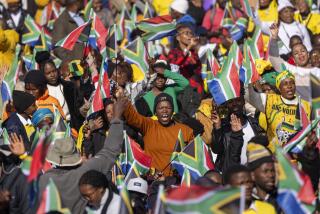A Different Kind of Bias Is Behind White Support of the ANC
- Share via
As human-rights organizations throughout the world flex their muscles for another onslaught against apartheid in the new year, black South Africans hope that these groups will stop being partisan in their support for the liberation struggle.
If the Western world is committed to the creation of a just society in South Africa, it should accept the democratic right of black South Africans to decide which organization--the African National Congress (ANC), the Pan-Africanist Congress (PAC) or the Black Consciousness Movement (BCM)--represents their aspirations.
Several overseas organizations insist that the ANC should be the sole representative of South Africa’s oppressed masses. Thus only its accredited representatives were given the platform at many meetings in Europe, Canada and the United States.
Financial assistance inside South Africa to anti-apartheid organizations has also been biased. Of at least $40 million given annually, less than 10% went to organizations supporting PAC or BCM policies.
Among the many reasons why white supremacy has thrived were the government’s policies of divide and rule. By favoring the ANC against the PAC and BCM, the overseas community must ask if it is not deepening the wedge in the black community and assisting the government in keeping blacks divided.
Various arguments as to why the ANC must be the only recipient of international support have been given, the major one being its stability over the years.
The adoption of the Freedom Charter, the ANC’s blue-print for a non-racial South Africa, by two of the largest organizations in the country, the United DemocraticFront and the Congress of South African Trade Unions, reflects the wide support for the ANC, its backers argue. The two groups are not ANC affiliates, but they supportmany of its policies. It is also stressed that the admission of white members by the three organizations shows their commitment to a non-racial future. Conversely, since groups supporting PAC and BCM policies do not accept white members, their commitment to nonracialism cannot be trusted.
Supporters of PAC and BCM argue that downtrodden communities throughout the world and history have been bound together by their suffering and that therefore it is not wrong for blacks to be drawn to each other because of their oppression. “Also, we are as committed to a non-racial South Africa as the ANC is, but differ on strategies,” one activist explained. “Zimbabwe is a classic example. Whites feared Robert Mugabe but have now found he is not the monster he was made out to be. The same will apply in Azania (South Africa). The PAC has even declared that ‘in a liberated Azania the color of a man’s skin shall be as irrelevant as the shape of his ears.’ ”
Further, it is argued that the Azanian People’s Organizations, Azanian National Youth Unity, African Women’s Organization and Azanian Coordinating Committee, all opposed to the Freedom Charter, were just as active and had followings as large as the United Democratic Front and the trade-union congress.
“However, as our rivals enjoy millions of dollars in assistance they are able to bus members to meetings, organize conferences, print T-shirts and employ full-time workers. As these activities attracted the press and were reported on, it is assumed Freedom Charter organizations are stronger. But the question to be asked is, can they survive or get members to meetings without external funding? We have survived,” the activist commented.
He also pointed out that the adoption of the charter had split or created tensions in several organizations while others, including the United Democratic Front and the trade-union congress, had not adopted it.
If overseas organizations studied political trends in South Africa’s townships more closely, they will note that support for the African National Congress or the Pan-Africanist Congress varies from area to area and time to time. Recent trends show that the PAC has gained the upper hand, while between 1984 and 1986 the ANC rode the crest of a wave. The picture may be different tomorrow. Rivalry between the two dates back to 1958, when a faction of the ANC left to form the PAC.
Among the differences between the two is the ANC’s assertion that “South Africa belongs to all who live in it, black and white,” while its rivals say that occupation of the land by whites during colonialism does not entitle them to ownership. “When whites agree that the land belongs to us and accept majority rule, the contradictions between us shall have ceased,” said a PAC spokesman. The two groups also differ on participation of whites in the liberation struggle. The ANC and its supporters accept them in their organizations while the PAC and allied groups believe that the presence of whites in black organizations neutralizes black militancy.
The case for nonsectarianism is strengthened by the cooperation of all groups in the country during the the past four years when there were class and consumer boycotts in some townships, and there is an ongoing rent boycott.
More than 2,000 people have died over the past two years, and more than 20,000 have been detained. It cannot be said that all of these victims were supporters of organizations that have adopted the Freedom Charter.
People in Europe and America rightfully reject President Pieter W. Botha’s determination to control the lives of blacks. Why do they want to decide which of our political organizations is acceptable?
More to Read
Sign up for Essential California
The most important California stories and recommendations in your inbox every morning.
You may occasionally receive promotional content from the Los Angeles Times.













